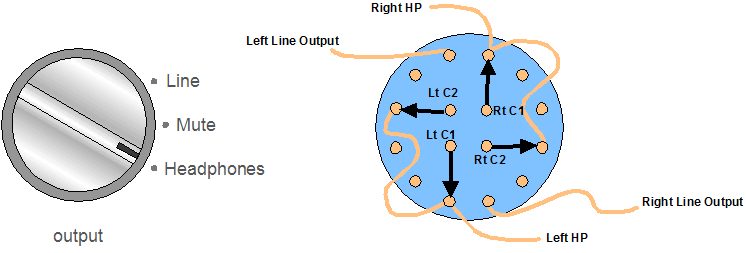| John Broskie's Guide to Tube Circuit Analysis & Design |
21 April 2006
What’s wrong with loudspeakers? A loudspeaker’s crossovers and massive diaphragms smear the sonic minutia, rolling over the barely audible information, washing away the recording’s sonic fingerprints, like a blurry photograph that truthfully reveals a dress’s color, but not its texture. Here is a simple experiment: visit a music store and listen to the sonic signature of each type of cymbal displayed; then go home and listen to your loudspeakers. What happened to that obvious and marked difference in timbre? Now listen to the same recordings with high-quality headphones. Can you hear more of the distinctions in size, brand, and composition of cymbals? (Yes, I know that CDs make this test much harder than LPs or tape did.) To subtract further, the little that the loudspeaker can faithfully reproduce pours into a sonic coffin known as your listening room. Parallel walls, floor, and ceiling reverberate unevenly, stressing some frequencies, but attenuating others. I imagine that even the air between a loudspeaker and your ears subtracts from what the ear could hear directly against the loudspeaker; being no more than a mixture of gasses, how could we expect it to hold a precise imprint for very long before its natural sponginess smears the finest details? Here is an additional experiment: sit in the front row of a concert hall and listen to the amazing brightness, if not downright harshness of many of the orchestra’s instruments. Then move to the rear of the hall and sit in an untaken seat and listen to the soft, murky sound, where many discrete violins meld into one fat, large violin. Verily, headphones circumnavigate so many sonic snares that it is amazing that more are not ardent headphone listeners.
The problem with headphones I know some are thinking: What about electrostatic loudspeakers? Surely they can match the headphone’s magnifying-glass sharp detail? And I have to admit that the best electrostatic loudspeakers can come close to matching the best dynamic headphones, but I hold that they cannot equal the delicacy of the best electrostatic headphones. So when we compare apples to apples and oranges to oranges, the same relationships obtain. Many shy away from headphones because they miss the visceral impact that big loudspeakers deliver, the shaking of the floor and body, which no headphone can reproduce. No debate here. In fact, that is why I have been using subwoofers with my headphone listening for almost thirty years. Just limit the subwoofer’s high-frequency bandwidth to 70Hz to 100Hz and adjust its level to the point where it is only felt, but not heard with the headphones playing. Finally, consider this: 99.9% of the headphone listening you have done in your life has been through solid-state amplifiers. How many Walkmans have you owned that sported a vacuum-tube output stage? So, if you dislike headphone listening, are you sure it is not the miserable little solid-state OpAmps that you actually dislike? Now, when high-quality headphones meet vacuum tubes, real magic results. Gone are the obnoxious solid-state artifacts that can sometimes make dull loudspeakers sound sparkling. Gone are the ridiculous class-B OpAmps found in most receivers and in all MP3 players. (In an MP3 player, battery life is critical and a class-A output stage would be lethal to playing time.)
Aikido headphone amplifiers 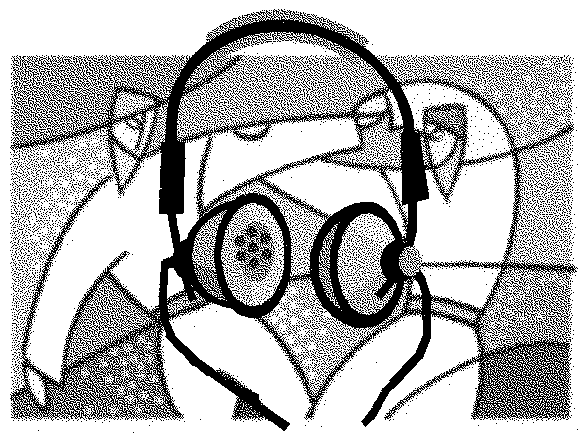
But then there are the e-mails from readers who tell me that they are using an Aikido amplifier as a headphone amplifier and that they love the sound. Normally, I instinctively discount such testimony, as just about any circuit or modification can provoke such enthusiasm. But I am reminded of my once dim view of using the Broskie cathode follower as a headphone amplifier. One reader told me that his Sennheiser HD-600s never sounded better than they hooked up to a 6922-based Broskie cathode follower. I couldn’t see the circuit being happy driving such a low load impedance, but after modeling it in SPICE and after being suitably impressed, I tried it myself with the HD-580s I used at the time. Darned if he wasn't right. Recently, I have hooked up my HD-650s to a 6SN7-based Aikido amplifier (bypassing my excellent custom-made Tribute Audio headphone transformers) and it also sounds great. Still I worry. Although my wife finds it hard to believe, of all the audiophiles I know, I listen at the lowest volume levels. So I fear the that the headphone user who likes to share his music with those across the street from him will be disappointed by the small amount of ringing in his ears that an Aikido linestage amplifier can muster. In other words, I believe that if an Aikido amplifier is going to drive headphones, it must be designed carefully and robustly overbuilt.
Getting serious So, our first design objective is to limit expected load impedance to no less than 300 ohms and to limit our choice of output tubes to those robust enough to drive 300 ohms effortlessly. In other words, no 12AU7s or 6SN7s or, even, 6N1Ps need apply. These tubes have their uses, but none can deliver enough current into a 300-ohm load in a single ended output stage. (Yes, I know that there is a company that sells highly respected headphone amplifiers that sport 6SN7s throughout, but I also know that the output stage is a push-pull one.) Single ended operation means that the idle current is also the current limit into the load. On the other hand, a push-pull operation allows peak current to equal twice the idle current in a class-A amplifier and they sky is the limit in a class-AB or class-B amplifier. How much current is needed to drive 300-ohm headphones? It depends on the headphones. I have played my Sennheiser headphones at the loudest level I would ever want to withstand; then I replayed the track into an oscilloscope. The highest peak voltage I ever saw was about 3 volts, which translates into a peak of 10mA, which in turn equals 15mW. To buy some extra headroom, let’s double this peak current to 20mA. So, will 20mA always be enough? No, I doubt it, as some 400-ohm headphones are much less efficient; but at least the sizable Sennheiser crowd will be satisfied.
Octal Aikido headphone amplifiers 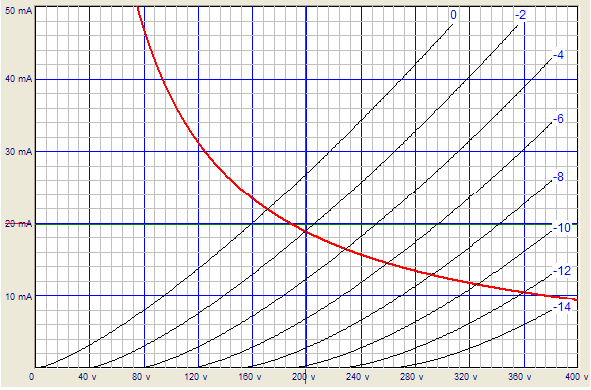 Now, the 6BX7’s curves: 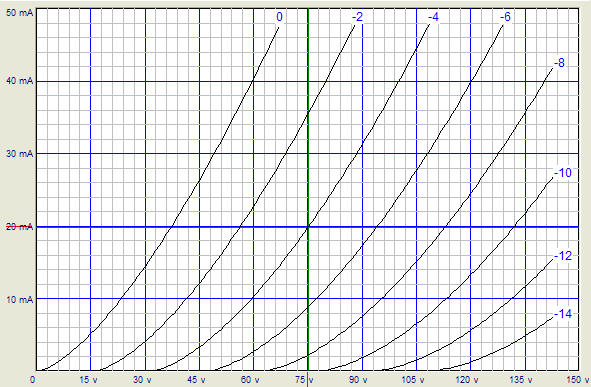
Note how the 6BX7’s 10W plate dissipation limit does not even intrude into the graph’s confines. At 75V and 20mA, its mu is 9.5, which gives us the ratio of 60.5% of power supply noise to be injected into the bottom triode’s grid. This ratio can be realized through a 64.9k resistor standing on top of a 100k resistor, or a 100k resistor standing on top of a 152k resistor. Now, what remains is to determine the cathode resistor values. First of all, we want the lowest output impedance possible, so we cannot tolerate the added resistance from the cathode resistor; thus, we forgo using a cathode resistor for the top tube and we bypass the bottom triode’s cathode resistor. 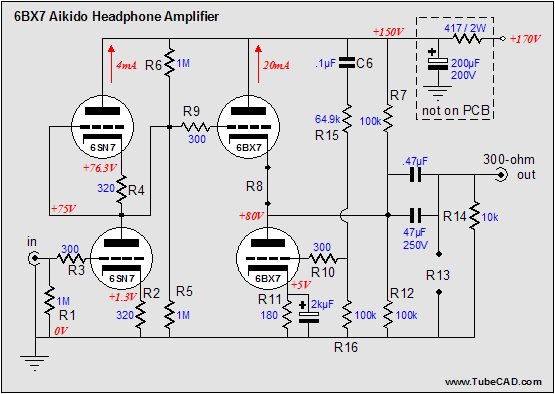
Well, there it is. The 6SN7/12SN7/12SX7 makes a fine input tube. Both channels draw a total of 48mA. The (external to the PCB) 417-ohm resistor drops the raw 170V down to a fairly filtered 150V. The 170V power supply is easily built from full-wave-bridge rectifying a 120Vac isolation transformer. So, how good is this headphone amplifier? I haven’t actually built it, so I am only guessing here, but I am unhappy about the added bypass capacitor across the bottom triode’s cathode resistor. One of the great features of the Aikido topology is that it uses cathode resistance to its advantage, linearizing the triodes without incurring too large a penalty in increased output impedance. Besides, always try to avoid placing an electrolytic capacitor in the cathode circuit, as it can only harm the signal. In addition, I worry about the 6BL7 or 6BX7 not being as linear as the venerated 6SN7, particularly without the top cathode resistor. So I would first build this circuit with both 180-ohm cathode resistors in place, unbypassed; if the bass is acceptable, then let it be; if not, try removing the top cathode resistor and tack solder a bypass capacitor across the bottom cathode resistor.
iPod trick 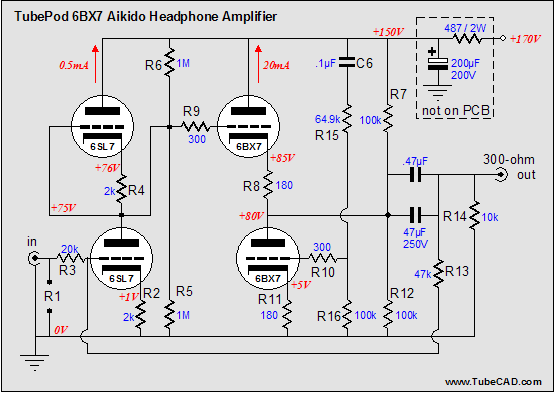
The schematic above shows an iPod-ready Aikido headphone amplifier that uses a global feedback loop to lower distortion, noise and output impedance, while keeping the output stage’s cathode resistors in place, and unbypassed. The 6SL7/12SL7/6SU7 offers much more gain to power the feedback loop. (Note this circuit will require some PCB hacking.)
Output coupling capacitors Although the Aikido octal PCB will hold some physically very large capacitors, such capacitors can work their way free from the board if the amplifier is shaken enough. Thus, I always recommend using some hot glue or tie strips to hold large capacitors in place. (An added advantage to holding large capacitors down is that all capacitors have a microphonic quality, which the glue or strips helps dampen. I always place a small section of Sorbothane below each coupling capacitor, for this reason.) What if you plan on driving both power amplifier and headphones, but not at once. A rotary switch can be configured to allow giving the line output only the high-quality 0.47µF coupling capacitor, but paralleling both coupling capacitors when driving headphones (with a center position of mute). Below is how to wire such a switch.
Next time //JRB
|
|
| www.tubecad.com Copyright © 1999-2006 GlassWare All Rights Reserved |
